A homeowner’s association (HOA) is an organization that governs a “common interest” community. It can be a community consisting of townhouses, individual single-family homes, high-rises, or condos. HOA creates and enforces rules and bylaws to maintain a community. When you buy a home in a managed community, you’re also agreeing to legal entitlements and obligations on top of purchasing a home. Some of the most common commitments you’re going to have when you purchase a home within a managed community are attending meetings, having regular inspections, and paying fees.
Knowing these things makes you wonder; Do homeowners like being part of HOAs? Or is being a member of an HOA worth it? Here are some facts and statistics that will answer your questions.
Key Takeaways
- There are 10 states with the lowest percentage of homes belonging to HOAs. Most of the states with the fewest number of HOAs are located in the Midwest and South, namely Oklahoma, Mississippi, and Arkansas. Interestingly, the housing costs in these states are relatively high.
- About 35% of homeowners spend more on HOA fees than their monthly mortgage payments. Despite this fact, a lot of homeowners are happy with their memberships because HOAs make their lives easier.
- HOA fees were significantly affected by inflation and rising costs as 91% of community managers and board members have seen an unexpected increase in their expenses. Most of these board members are planning to have an increase of up to 10% in their fees.
- People from Generation Z make up 47% of HOA memberships. However, Baby Boomers tend to love being part of HOAs. Generally speaking, most homeowners are happy being HOA members to the point that they even consider it an essential factor when buying their homes.
Facts & Statistics
Industry Outlook
Homeowners associations are entities that don’t only provide housing to families. They also contribute to the country’s economy. Here are some figures you need to know:
- In the United States, there are three types of community associations: Homeowners Association, Condo Communities, and Co-ops. HOAs make up 60% of association types. There are 38% of condominium communities and 2% of cooperatives. In real estate, the term homeowners association is used regardless of whether the residents own single-family homes or condominiums.
- In 2020, there were about 55,000 to 60,000 community managers in the United States. This includes on-site managers and individuals who support the communities part-time.
- Also in 2020, there were about 6,000 to 9,000 large-scale community associations in the United States. These large-scale community associations meet two of the three characteristics: a minimum of 1,000 lots and/or homes, a minimum annual budget of $2 million, and a single, continuous community with a general manager.
- In 2020, community associations contributed a total of $306 billion to the economy. This includes real estate taxes, housing services, home improvements, and volunteer time.
- The total assessments collected from homeowners in 2020 was $103.3 billion. The assessment funds were used for a lot of important community obligations, such as security, insurance, professional management services, utilities, and common area maintenance.
- About $25.8 billion worth of assessments were contributed to association reserve funds in 2020. These reserve funds are used for the repair, replacement, and enhancement of common property.
- Community associations contribute a total of 97,600,000 hours of volunteering. These volunteer hours of service are annually performed by association committee members and the board to provide services to their respective communities.
- The estimated value of time provided by HOA boards and members is about $2.908 billion. The volunteer hourly time is calculated for each state and has an average of $28.54/hour.
- There are about 363,000 community associations in the United States. There are over 40 million entities in the US–governmental, charitable, business, and community associations. Community associations make up 0.9% of the total 40 million.
- The total number of community associations has increased 35 times. In the 1970s, there were only around 10,000 community associations in the United States. This number increased to 363,000 in 2022.

- In 2020, the total housing units in HOAs reached 27,500,000. As the number of communities and residents increased over time, the number of housing units increased as well. There were only 700,000 housing units in HOAs in the country in 1970.

- About 47% of Gen Z are HOA members. This is followed by six-figure earners (45%). Memberships are, however, least common among parents with adult children (26%) and individuals who earn less than $50,000 (27%).
- Men tend to spend more on HOA fees than women. On average, men spend an average of $317 on monthly HOA fees, which is greater than women ($245).
Geographical Statistics
Homeowners associations are popular in the United States–especially in the states of Florida, California, and Colorado. However, they don’t seem to be as popular in the Midwest and the South. To know more, here are geographical statistics:
- HOAs are most popular in California with 4.9 million homes belonging to HOAs. This is closely followed by Florida with a total of 3.9 million homes in HOAs.
HOA Populatiry by State
<table><tr><th>State</th><th>Number of Homes in HOAs</th><th>Percentage of Homes in HOA</th></tr><tr><td>California</td><td>4947000</td><td>37%</td></tr><tr><td>Florida</td><td>3855000</td><td>45%</td></tr><tr><td>Texas</td> <td>2142000</td><td>20%</td></tr></table>
- There are 10 states with the lowest percentage of homes belonging to HOAs. These states are Kentucky (6.2%), New Mexico (6.1%), Kansas (5.3%), Nebraska (5.3%), Alabama (5.0%), South Dakota (4.8%), West Virginia (4.2%), Oklahoma (4.1%), Mississippi (2.5%), and Arkansas (2.2%).
- States with the fewest HOAs are located in the Midwest and South–Arkansas, Oklahoma, and Mississippi. These states have less than 5% of homes that are part of HOAs. Arkansas only has 2.2%, Mississippi has 2.5%, and Oklahoma has 4.1%.
- The median home value across the 10 states with a lower percentage of HOAs is less than $200,000. The states with the fewest HOAs tend to have lower home values. This is except Nebraska and South Dakota, with home values of $219,900 and $204,900, respectively.
- The average monthly HOA fee in Missouri ($469) is nearly $200 higher than in Wisconsin ($277). The average monthly HOA fee ranges from $300 to $400 in 43 states.
- Missouri has the highest average monthly HOA fee ($469). This is followed by Arizona, which has a monthly HOA fee of $448.
HOA Fees by State
<table><tr><th>State</th><th>Average Annual Fee</th><th>Average Monthly Fee</th></tr><tr><td>California</td><td>$4,649</td><td>$387</td></tr><tr><td>Florida</td><td>$4,669</td><td>$389</td></tr><tr><td>Texas</td><td>$4,669</td><td>$389</td></tr></table>
- In West Virginia and Mississippi, the HOA fee exceeds 3% of the median home value. The HOA fees are disproportionately high when compared to the median home values of these states. West Virginia has a median home value of $143,000 and an average annual HOA fee of $4,700. Mississippi, on the other hand, has a median home value of $145,600 and an annual HOA fee of $4,750.
- West Virginia and Mississippi have the lowest prevalence of HOAs. Homeowners in these states are less likely to be part of an HOA because the costs are relatively high in terms of housing costs.
Costs
With the inflation and rising costs, it would only make sense that HOA fees increase as well. For some, HOA fees tend to be higher every month. Here are some facts you need to know about the cost of HOA fees:
- In a survey among homeowners, about 35% or more than 1 in 3 people said that they belong to an HOA, dishing out more than their monthly mortgage payments. These homeowners believe that an HOA can help protect and grow the value of their homes.
- An average of $291 on monthly fees is being spent by homeowners who are part of HOAs. Annually, the fees cost $3,500.
- This year, 91% of community associations reported that they’ve seen an unexpected increase in their HOA expenses. This increase was caused by inflation and rising costs. Only 6% of community associations mentioned that they didn’t see any increase, while 3% were not sure if there was any increase.
- Management costs account for 92% of increased expenses in HOAs. The effect of inflation and rising costs tends to reflect on community associations’ management expenses. This is followed by insurance costs (91%), maintenance costs (85%), staffing (74%), and landscape service (72%).
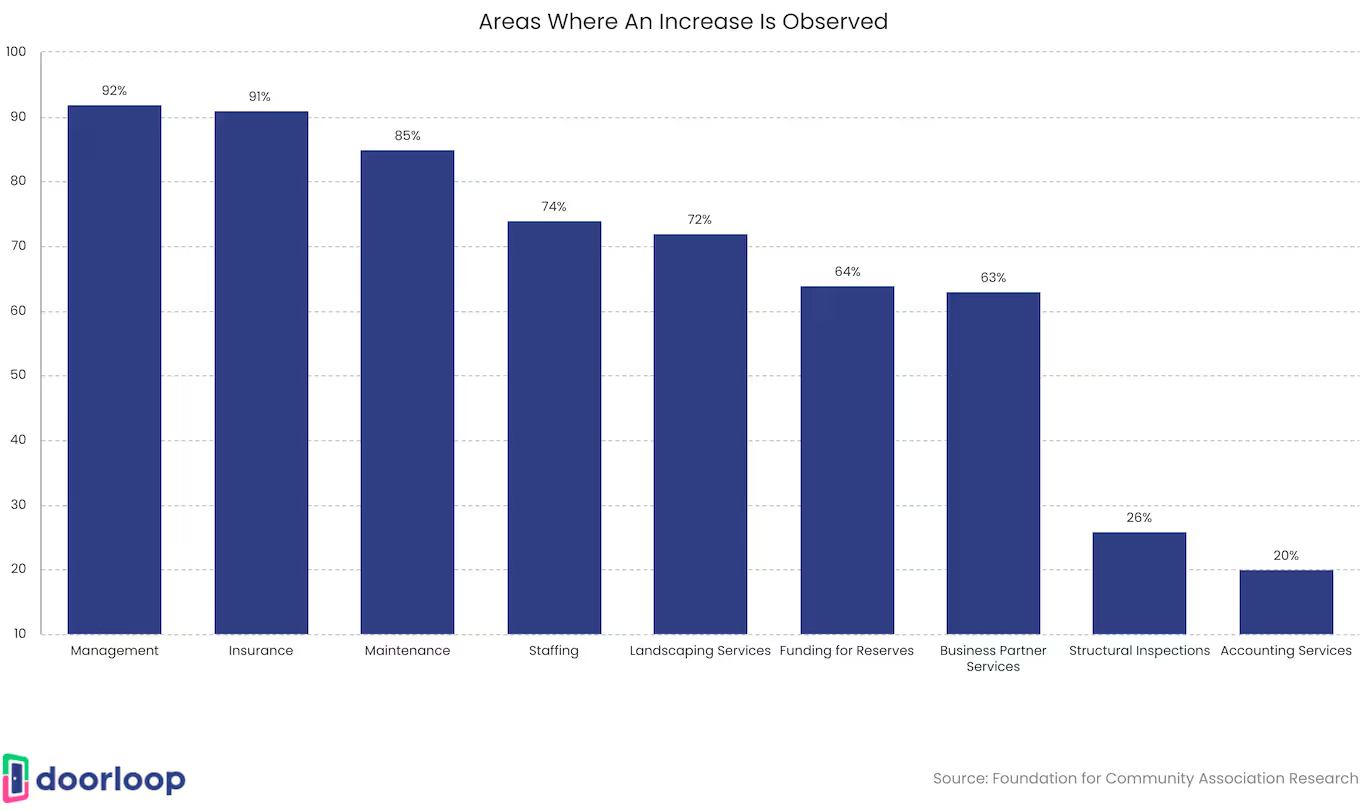
- Due to the unexpected increase, 73% of HOAs plan to address the issue by increasing assessments. Only 41% of community associations plan to reduce expenses and only 15% are looking into reducing reserve contributions.
- For the community associations that are planning to reduce expenses, 40% are looking into deferring maintenance. About 31% plan on reducing landscaping, 18% plan to reduce legal fees, and 14% are going to reduce their amenities.
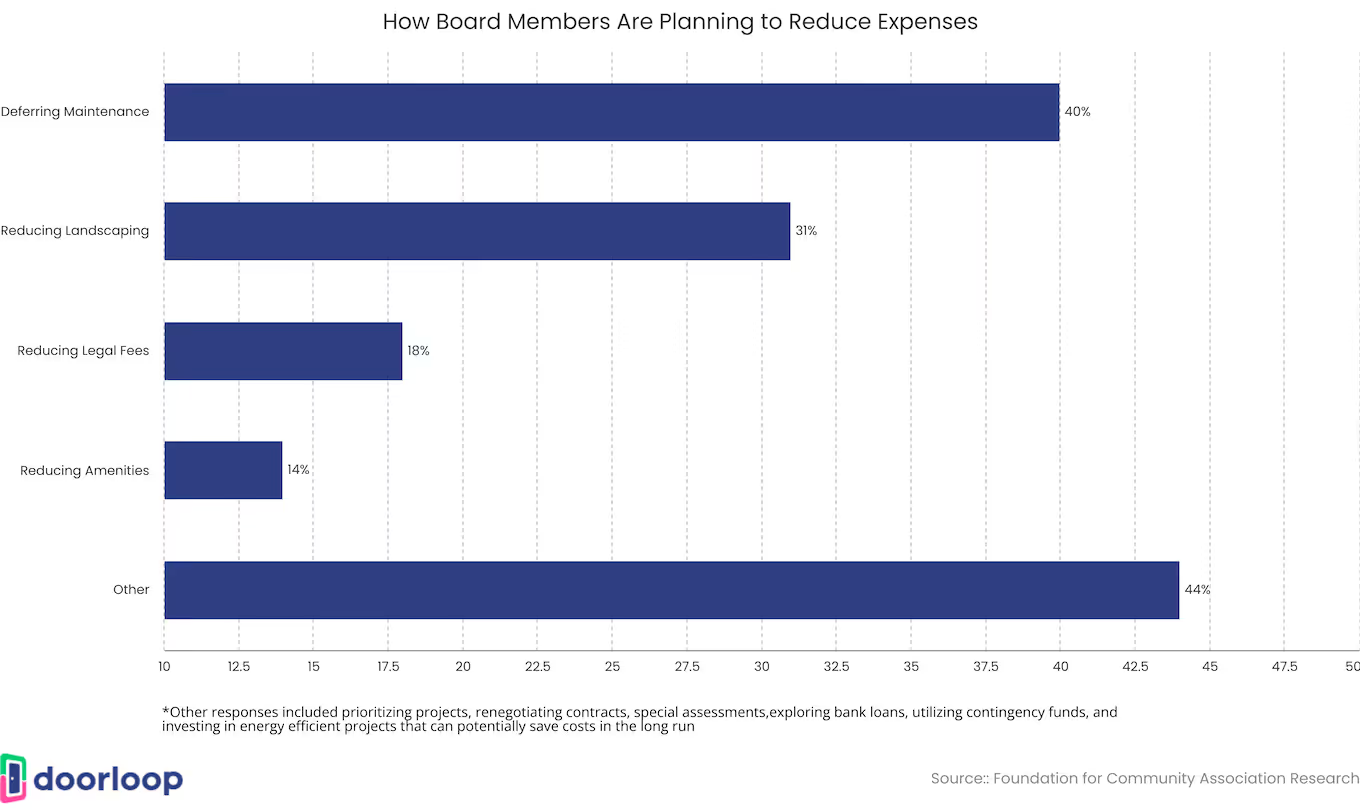
- With the increase in HOA fees, 91% of community associations also reported that their budget for this year increased. More than half of community associations (58%) said that their budget increased by up to 10%. About 30% needed to increase their budget by 11% to 25% due to the rising costs and inflation. Only 3% reported that they had to increase their budget by 26% to 50%.
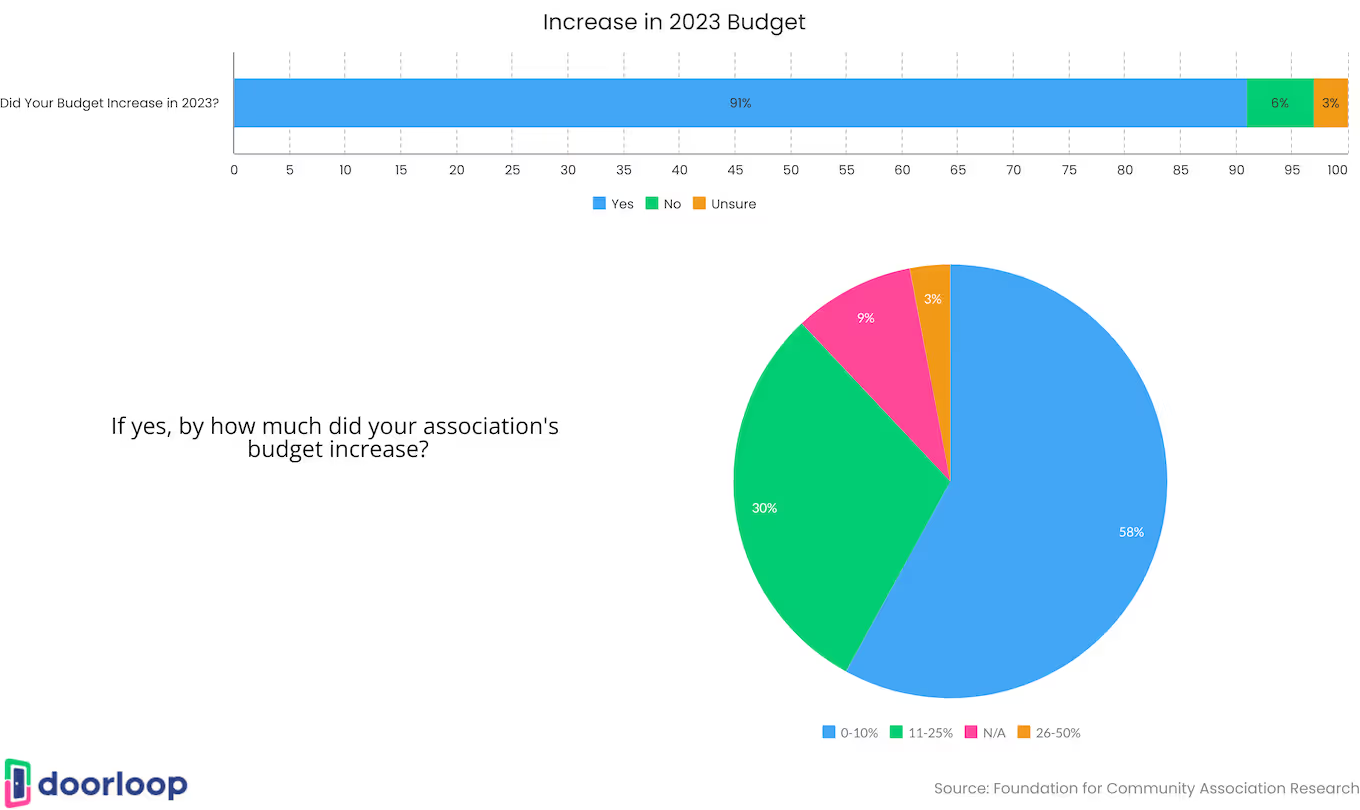
- Due to rising material costs, supplies, and other expenses, 71% of community managers and HOA board members plan to increase their fees in 2024. Only 9% reported that they have no plans to increase fees.
- For 71% of board members and managers who plan to increase their fees by up to 10%. About 19% reported that they’re planning to increase their fees by 11-25%.
- For 70% of residents, community associations should insist that every homeowner pay assessments. About 6% think that community associations should make up for the loss by increasing assessments for paying homeowners. For 10% of homeowners, services and amenities should be curtailed; such as delaying improvements, reducing pool hours, and spending less on landscaping.
Perception Toward HOAs
Plenty of homeowners have a love-hate relationship with their HOAs. Some people think HOAs make their lives easier, while others think that HOAs are just another figure that makes homeownership tough. Here’s how homeowners perceive their community associations through the years:
- For 44% of homeowners, being a member of an HOA is an important factor in buying their homes, and are happy with their decision. About 31% said that they wanted to be in an HOA, but regretted it after purchasing their home. For 16% of homeowners, being part of an HOA is something they didn’t want in the first place.
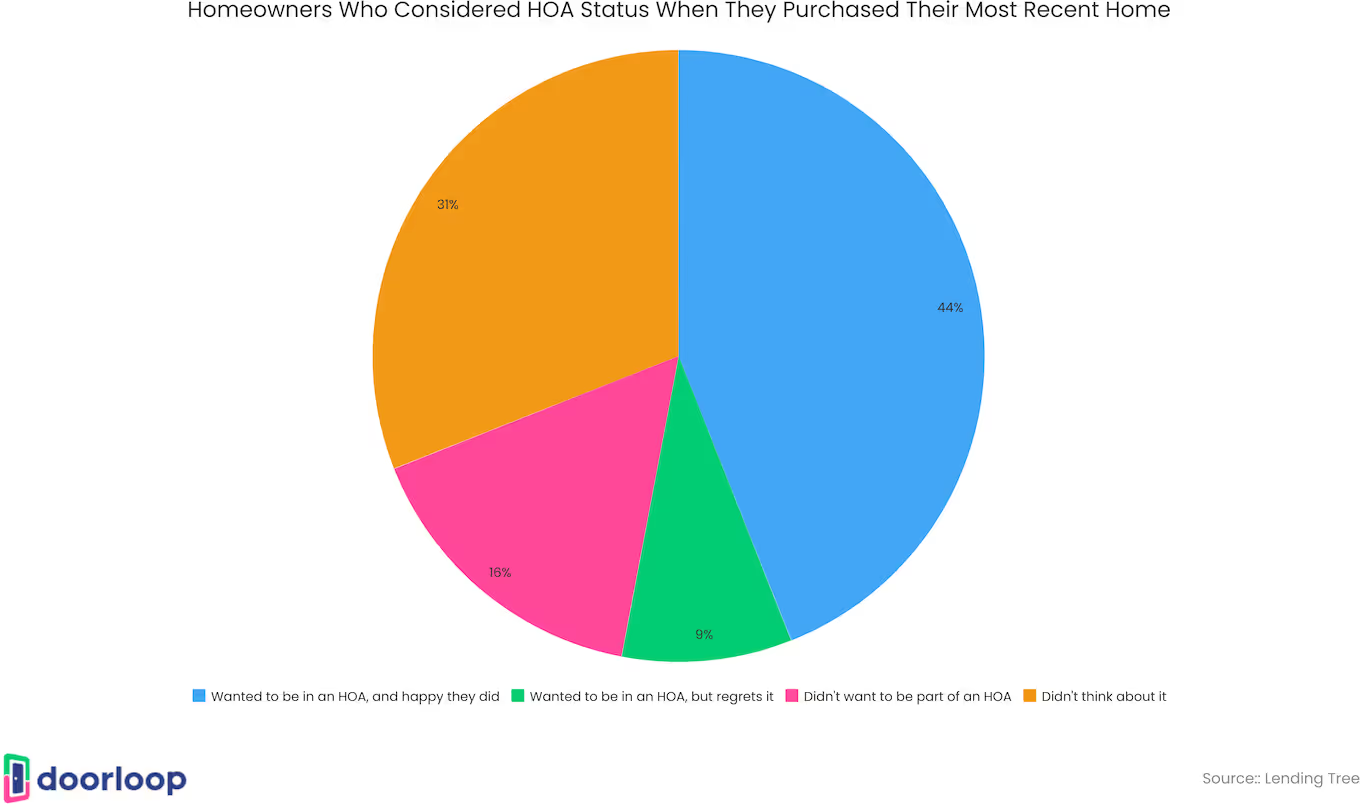
- More than half (57%) of HOA members reported that they’re happy with their membership as it makes their lives easier. For 23% of homeowners, however, their lives have been made more complicated by their HOA membership.
- Neighborhood landscaping is the most common service included in HOAs (64%). Other services commonly offered by HOAs include security (44%), personal landscaping (34%), sports and leisure amenities (31%), and concierge (10%).
- For 63% of homeowners, the value of their HOA membership is fairly priced. About 35% reported that the fees are too expensive for the benefits they get. Only 2% of homeowners agreed that the fees are underpriced for the benefits.
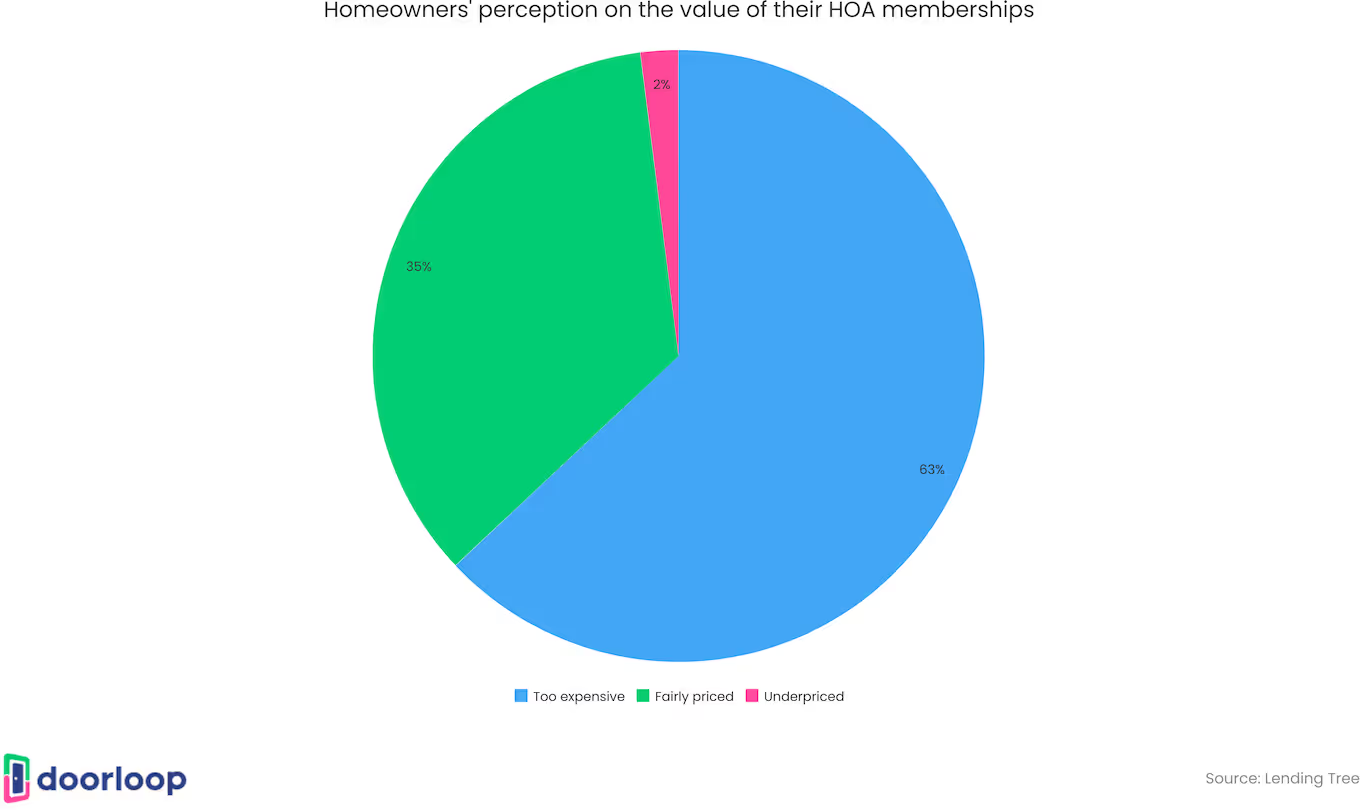
- Only about 15% of homeowners received a violation from their HOAs. The majority of homeowners (85%), however, have never been in violation of their HOAs.
- Landscaping-related issues are one of the most common violations homeowners experience (34%). About 23% of homeowners get violations for design changes, 23% for fencing issues, and around 21% get violations for issues related to trash pickup.
- More than half of Baby Boomers (52%) love HOAs. Among three generations–Millennials, Gen X, and Baby Boomers, the Baby Boomers seem to love being members of HOAs. Only 17% of homeowners from this generation hate HOAs. About 39% of Millennials love HOAs and 27% hate them. Homeowners from Gen X seem to hate HOAs more (32%).

- More than half of current or previous HOA board members love being part of HOAs (57%). About 29% of these people are indifferent toward HOAs, while 14% hate this type of community association.
- For 59% of residents who were never on the HOA board, the monthly fees are worth it. However, 33% of these homeowners reported that these fees aren’t worth paying for. For 75% of people who are currently or previously on the HOA board, the fees are worth it. Only 16% of these people think that the fees aren’t worth spending money on.
- About 33% of Millennials are more likely to complain to their HOA when neighbors play loud music. Landscaping appearance is the most common complaint among homeowners from Generation X and pet waste is the top concern for 38% of Baby Boomers.
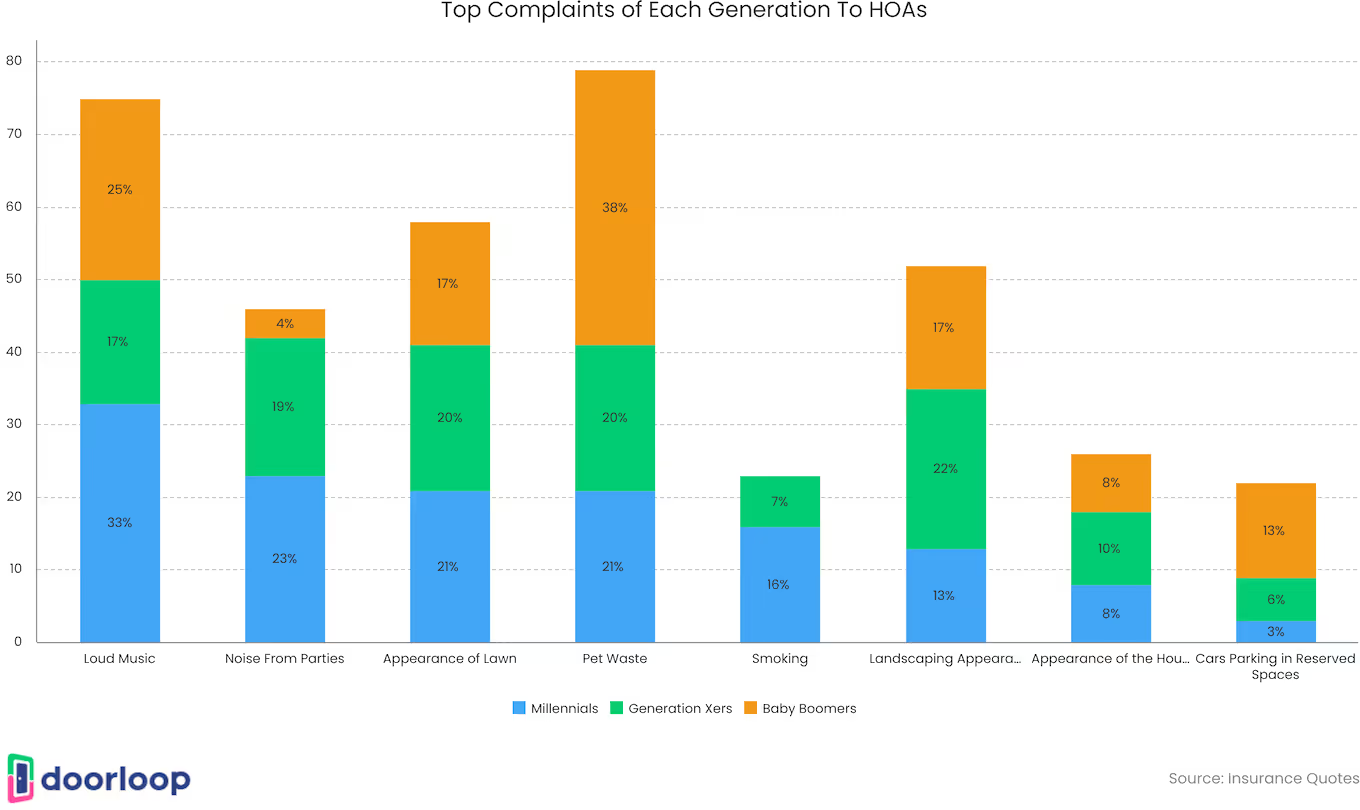
- The majority of Millennials (38%) and Gen Xers (39%) never attend HOA meetings. Baby Boomers, on the other hand, often attend these meetings (31%). Only 13% of homeowners from the Baby Boomer generation never attend HOA meetings.
- About 58% of homeowners, regardless of generation, attend HOA meetings to vote on important issues. Around 56% go to meetings to become aware of important decisions and 49% to voice their opinions. Some homeowners attend HOA meetings to see a fight (5%) or to see which neighbors cause drama (10%).
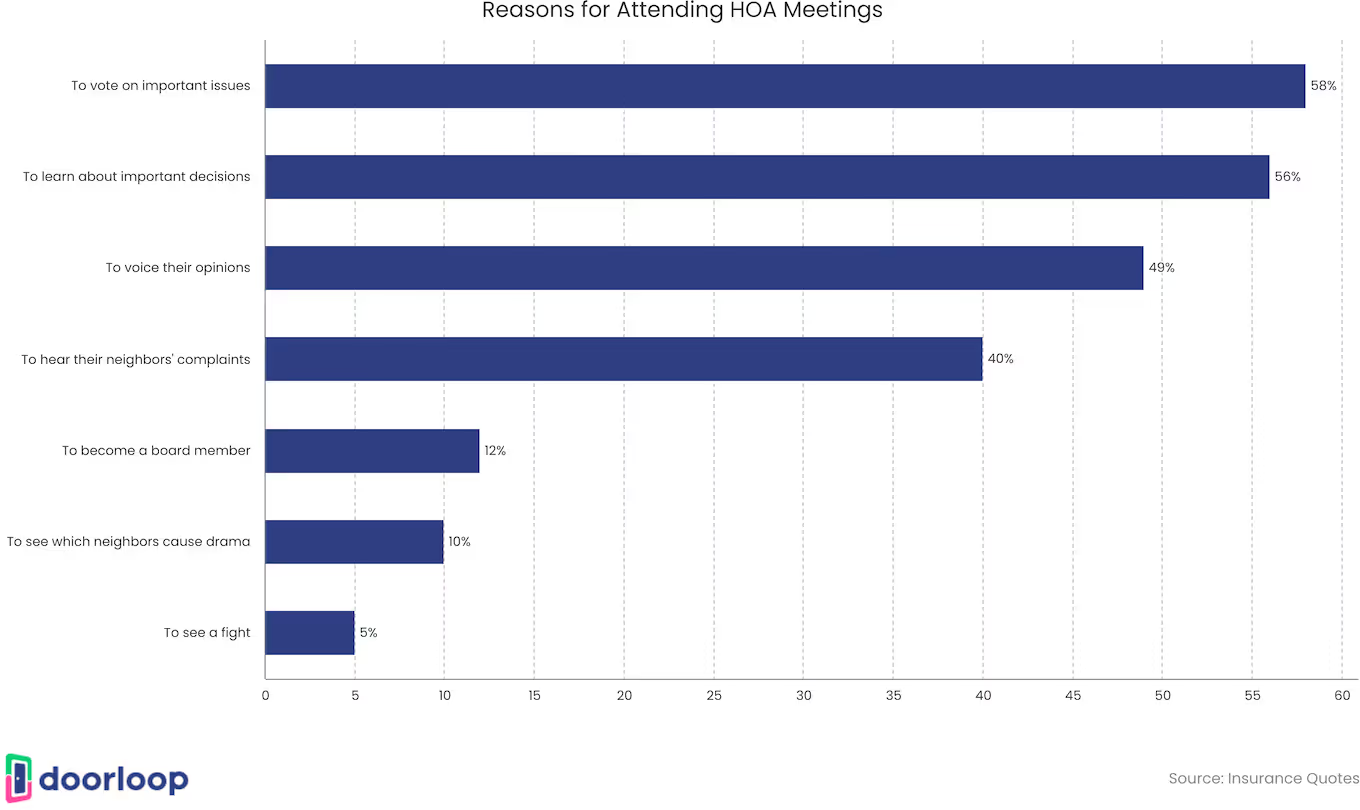
- For 63% of homeowners don’t attend HOA meetings simply because they don’t have time. About 48% do not attend because they’re not interested, while 27% of homeowners don’t bother attending because they think their opinions don’t change anything. For 9% of homeowners, meetings are too hostile and 6% don’t attend simply because they don’t like their community.
- Around 35% of homeowners agree that HOA rules should have improved parking regulations. About 29% of homeowners want to have improved noise regulations and 15% need rules on pet waste.
- Around 27% of homeowners hate lawn appearance policies in HOAs as it has the most negative impact on them. This is followed by parking regulations (15%) and pet restrictions (13%).
- In 2020, 89% of residents rated their community association experience as very good. About 70% of individuals rated their experience as good, and 19% were neutral.
- At the same time, about 89% of residents reported that they were on friendly terms with their community association board. This is an improvement from 81% in 2018, but lower than it was in 2012 (91%) and 2014 (92%).
- About 89% of residents mentioned that the members of their elected governing board work to serve the best interests of the community as a whole. Accordingly, the elected members of the board “absolutely” or “for the most part” serve the best interests of their communities.
- When it comes to community association governance, 74% of residents prefer less government control or no changes within their associations. The governance of community associations is subject to different state laws and regulations; more than half of residents prefer it when the government has less control over their community.
Simplify dues collection, budgeting, and communication with our all-in-one HOA management software
FAQs
What is the average HOA fee in America?
The average monthly HOA fee in 43 states ranges from $300 to $400. In Missouri, however, the average monthly HOA fee is $469. Generally speaking, the average amount spent by homeowners on HOA fees is about $291, which is a total of $3,500 annually.
Which state has the most HOAs?
In 2024, Florida has the most homes belonging to HOAs. Out of 8.9 million homes in Florida, 3.9 million of those are in HOAs–which is about 45%. This number is closely followed by Colorado, with 893K homes in HOAs out of 2.3 million homes–a rate of 38.6%.
How is inflation affecting HOA fees?
About 91% of community associations noticed an unexpected increase in their expenses; mainly due to rising material costs, supplies, and other expenses. Consequently, around 71% of board members are planning to increase their fees by up to 10%, while 19% are planning to increase their fees by 11-25%.
Are homeowners associations good?
Plenty of homeowners are happy with their HOA memberships. About 57% of homeowners are so glad because their HOAs make their lives easier. About 44% of homebuyers consider HOAs as one of the most important factors to consider when buying a new home.
Are HOA violations common?
There are only 15% of homeowners who received a violation from their HOAs. It’s a small number compared to the 85% who have never received any violation from their HOAs. The most common violation, however, is related to landscaping as 34% of homeowners have issues regarding this aspect. About 23% get violations for design changes, 23% for fencing issues, and around 21% get violations for issues related to trash pickup.
Sources
- caionline.org
- insurancequotes.com
- lendingtree.com
- todayshomeowner.com
- statista.com
- redfin.com
- attomdata.com
- hopb.co
- census.gov
































.svg)
.svg)

